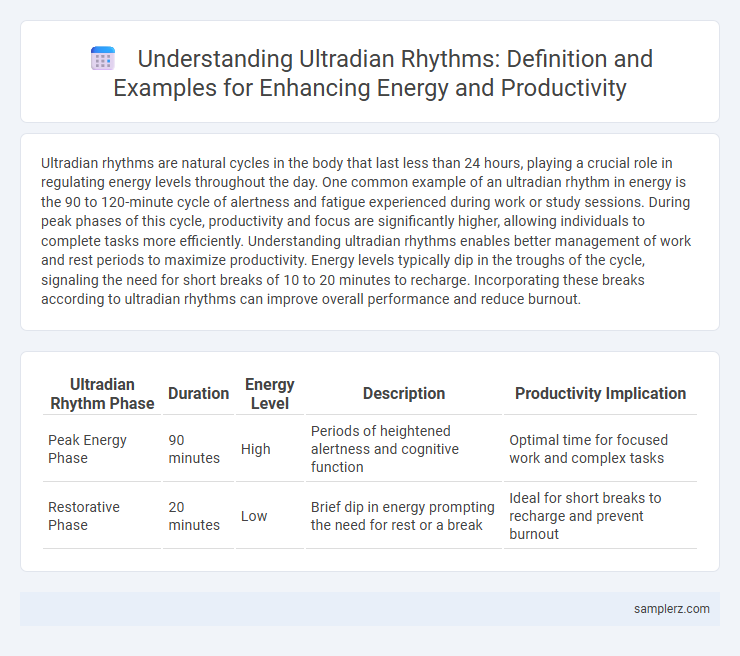Ultradian rhythms are natural cycles in the body that last less than 24 hours, playing a crucial role in regulating energy levels throughout the day. One common example of an ultradian rhythm in energy is the 90 to 120-minute cycle of alertness and fatigue experienced during work or study sessions. During peak phases of this cycle, productivity and focus are significantly higher, allowing individuals to complete tasks more efficiently. Understanding ultradian rhythms enables better management of work and rest periods to maximize productivity. Energy levels typically dip in the troughs of the cycle, signaling the need for short breaks of 10 to 20 minutes to recharge. Incorporating these breaks according to ultradian rhythms can improve overall performance and reduce burnout.
Table of Comparison
| Ultradian Rhythm Phase | Duration | Energy Level | Description | Productivity Implication |
|---|---|---|---|---|
| Peak Energy Phase | 90 minutes | High | Periods of heightened alertness and cognitive function | Optimal time for focused work and complex tasks |
| Restorative Phase | 20 minutes | Low | Brief dip in energy prompting the need for rest or a break | Ideal for short breaks to recharge and prevent burnout |
Understanding Ultradian Rhythms in Daily Energy Cycles
Ultradian rhythms are natural cycles occurring every 90 to 120 minutes that regulate fluctuations in energy and focus throughout the day. By recognizing these patterns, individuals can optimize productivity by aligning work sessions and breaks with peaks in cognitive performance. Leveraging ultradian rhythms enhances sustained attention, reduces fatigue, and supports efficient task management within daily energy cycles.
The 90-Minute Productivity Pulse: Classic Ultradian Example
The 90-minute productivity pulse exemplifies the ultradian rhythm by highlighting natural cycles of high energy and focus followed by brief periods of rest. During each 90-minute interval, cognitive performance peaks, making it an optimal window for deep work and creative problem-solving. Aligning tasks with these rhythms enhances efficiency and reduces mental fatigue, driving sustained productivity throughout the day.
Morning Energy Peaks: Harnessing Ultradian Highs
Morning energy peaks typically occur within the first few hours after waking, aligning with the brain's natural ultradian rhythms that cycle approximately every 90 minutes. During these high-energy phases, focus and cognitive performance reach optimal levels, making it ideal for tackling complex tasks and deep work. Leveraging these ultradian highs enhances productivity by syncing work periods with the body's innate energy fluctuations.
Ultradian Dips: Recognizing Natural Slumps in Performance
Ultradian dips represent natural declines in energy and focus occurring roughly every 90 to 120 minutes during the workday. These cycles reflect the body's biological rhythms, where cognitive performance temporarily decreases, signaling the need for brief rest or activity change. Recognizing ultradian dips enhances productivity by aligning work patterns with natural energy fluctuations, preventing burnout and maintaining sustained focus.
Power Napping: Optimizing Breaks with Ultradian Intervals
Power napping aligned with ultradian rhythms typically lasts 90 minutes, matching the brain's natural energy cycles and enhancing productivity and focus. These naps help reset cognitive function by allowing completion of a full sleep cycle, reducing the buildup of sleep pressure and mental fatigue. Implementing ultradian-timed breaks improves alertness and sustains high performance throughout the workday.
Task Scheduling Aligned with Ultradian Flow
Ultradian rhythms, typically lasting 90-120 minutes, significantly influence energy levels and focus throughout the workday. Scheduling tasks in alignment with these natural energy cycles enhances productivity by allocating high-demand activities during peak ultradian phases and incorporating breaks during lower-energy periods. This approach optimizes cognitive function, reduces burnout, and sustains consistent performance.
Physical Activity and Ultradian Energy Boosts
Ultradian rhythms influence physical activity by regulating energy levels in cycles of approximately 90-120 minutes, causing natural peaks and dips in focus and stamina. Engaging in short bursts of exercise, such as brisk walking or stretching during energy peaks, can enhance alertness and mental clarity. These ultradian energy boosts optimize productivity by aligning physical movement with the body's natural rhythm, preventing fatigue and sustaining consistent performance.
Creative Bursts Within Ultradian Cycles
Ultradian rhythms, occurring every 90-120 minutes, drive fluctuations in energy and creativity, with peak phases known as creative bursts enabling heightened focus and productivity. During these bursts, brainwave activity shifts, enhancing problem-solving, idea generation, and innovative thinking. Recognizing and aligning work tasks with ultradian creative peaks maximizes output and sustains mental stamina throughout the day.
Managing Fatigue: The Role of Ultradian Rhythms
Ultradian rhythms, cycles of approximately 90-120 minutes, significantly influence energy and focus by dictating natural peaks and troughs in alertness throughout the day. Managing fatigue effectively involves aligning work and rest periods with these rhythms, optimizing productivity by scheduling demanding tasks during peak energy phases and taking breaks during dips. Utilizing ultradian rhythm awareness enhances cognitive function and reduces burnout, leading to sustained performance and improved overall well-being.
Real-World Examples: High Performers Using Ultradian Timing
High performers like athletes and CEOs often align their work sessions with ultradian rhythms, working intensely for 90-120 minutes followed by focused breaks to recharge energy and maintain cognitive clarity. Studies reveal that embracing these natural cycles enhances sustained attention, decision-making, and overall productivity. Google and other top companies encourage ultradian-based work patterns by implementing scheduled breaks to optimize employee focus and efficiency.

example of ultradian rhythm in energy Infographic
 samplerz.com
samplerz.com